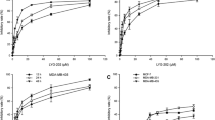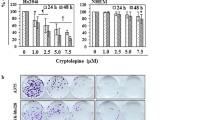Abstract
Growing interest in the beneficial effects of antioxidants has inspired the synthesis of new phenolic acid phenethyl ureas (PAPUs) with enhanced antioxidant potential. We have previously shown the capacity of one PAPU compound, (E)-1-(3,4-dihydroxyphenethyl)-3-styrylurea (PAPU1), to induce caspase-dependent apoptosis in melanoma cells. In the present study, we examined the anti-proliferative effects of PAPU compounds on MCF-7 human breast cancer cells and determined the molecular mechanisms involved. Treatment with PAPU compounds inhibited predominantly proliferation in these cells, where the PAPU1 was the most efficient form. Flow cytometric analysis showed that PAPU1 blocked cell cycle progression in the G0/G1 phase, and reduced the proportion of cells in G2/M phase. This was related to the inhibition of cell cycle regulatory factors, including cyclin D/E and cyclin-dependent kinase (CDK) 2/4, through induction of p21Cip1. PAPU1 also induced the mitochondrial-mediated and caspase-dependent apoptosis in MCF-7 cells. This was evidenced by cellular changes in the levels of Bcl-2 and Bax, loss of the mitochondrial membrane potential, release of cytochrome c into the cytosol, and caspase-9 activation. Collectively, our results suggest that G1 cell cycle regulatory proteins and mitochondrial pathways are the crucial targets of PAPU1 in the chemoprevention of breast cancer cells.
Similar content being viewed by others
References
Braun-Dullaeus, R.C., Mann, M.J., Sedding, D.G., Sherwood, S.W., Von der leyen, H.E., and Dzau, V.J. (2004). Cell cycle-dependent regulation of smooth muscle cell activation. Arterioscler. Thromb. Vasc. Biol. 24, 845–850.
Chen, Q.M., Liu, J., and Merrett, J.B. (2000). Apoptosis or senescence-like growth arrest: influence of cell-cycle position, p53, p21 and bax in H2O2 response of normal human fibroblasts. Biochem. J. 37, 543–551..
Chen, W.J., Chang, C.Y., and Lin, J.K. (2003). Induction of G1 phase arrest in MCF human breast cancer cells by pentagalloyl-glucose through the down-regulation of CDK4 and CDK2 activities and up-regulation of the CDK4 inhibitors p27Kip and p21Cip. Biochem. Pharmacol. 65, 1777–1785.
Cho, E.J., and Kim, G.H. (2008). Daidzein causes cell cycle arrest at the G1 and G2/M phases in human breast cancer MCF-7 and MDA-MB-453 cells. Phytomedicine 15, 683–690.
Conqueret, O. (2003). New roles for p21 and p27 cell-cycle inhibitors: A function of each cell compartment? Trends Cell. Biol. 13, 65–70.
Dzau, V.J., Braun-Dullaeus, R.C., and Sedding, D.G. (2002). Vascular proliferation and atherosclerosis: new perspectives and therapeutic strategies. Nat. Med. 8, 1249–1256.
El-Deiry, W.S. (1994). WAF1/CIP1 is induced in p53-mediated G1 arrest and apoptosis. Cancer Res. 54, 1169–1174.
Fang, S.C., Hsu, C.L., and Yen, G.C. (2008). Anti-inflammatory effects of phenolic compounds isolated from the fruits of Artocarpus heterophyllus. J. Agric. Food Chem. 56, 4463–4468.
Huang, C., Ma, W., Goranson, A., and Dong, Z. (1999). Resveratrol suppresses cell transformation and induces apoptosis through a p53-independent pathway. Carcinogenesis 20, 237–242.
Hudson, E.A., Dinh, P.A., Kokubun, T., Simmonds, M.S., and Gescher, A. (2000). Characterization of potentially chemopreventive phenols in extracts of brown rice that inhibit the growth of human breast and colon cancer cells. Cancer Epidemiol. Biomarkers Prev. 9, 1163–1170.
Jirawatnotai, S., Aziyu, A., Osmundson, E.C., Moons, D.S., Zou, X., Kineman, R.D., and Kiyokawa, H. (2004). Cdk4 is indispensable for postnatal proliferation of the anterior pituitary. J. Biol. Chem. 279, 51100–51106.
Kadoma, Y., and Fujisawa, S. (2008). A comparative study of the radical-scavenging activity of the phenolcarboxylic acids caffeic acid, p-coumaric acid, chlorogenic acid and ferulic acid, with or without 2-mercaptoethanol, a thiol, using the induction period method. Molecules 13, 2488–2499.
Kim, J.H., Jang, Y.O., Kim, B.T., Hwang, K.J., and Lee J.C. (2009). Induction of caspase-dependent apoptosis in melanoma cells by a synthetic compound, (E)-1-(3,4-dihydroxyphenethyl)-3-styrylurea. BMB Rep. 42, 806–811.
Konishi, Y., Hitomi, Y., and Yoshioka, E. (2004). Intestinal absorption of p-coumaric and gallic acids in rats after oral administration. J. Agric. Food Chem. 52, 2527–2532.
Konishi, Y., Hitomi, Y., Yoshida, M., and Yoshioka, E. (2005). Absorption and bioavailability of artepillin C in rats after oral administration. J. Agric. Food Chem. 53, 9928–9933.
Korkina, L.G. (2007). Phenylpropanoids as naturally occurring antioxidants: from plant defense to human health. Cell. Mol. Biol. 53, 15–25.
Lowe, S.W., Ruley, H.E., Jacks, T., and Housman, D.E. (1993). p53-dependent apoptosis modulates the cytotoxicity of anticancer agents. Cell 74, 957–967.
Martin, A., Odajima, J., Hunt, S.L., Dubus, P., Ortega, S., Malumbres, M., and Barbacid, M. (2005). Cdk2 is dispensable for cell cycle inhibition and tumor suppression mediated by p27 (Kip1) and p21(Cip1). Cancer Cell 7, 591–598.
Masuda, T., Yamada, K., Akiyama, J., Someya, T., Odaka, Y., Takeda, Y., Tori, M., Nakashima, K., Maekawa, T., and Sone, Y. (2008). Antioxidation mechanism studies of caffeic acid: identification of antioxidation products of methyl caffeate from lipid oxidation. J. Agric. Food Chem. 56, 5947–5952.
Mathew, S., and Abraham, T.E. (2004). Ferulic acid: an antioxidant found naturally in plant cell walls and feruloyl esterases involved in its release and their applications. Crit. Rev. Biotechnol. 24, 59–83.
Miranda, C.L., Stevens, J.F., Helmrich, A., Henderson, M.C., Rodriguez, R.J., Yang, Y.H., Deinzer, M.L., Barnes, D.W., and Buhler, D.R. (1999). Antiproliferative and cytotoxic effects of prenylated flavonoids from hops (Humulus lupulus) in human cancer cell lines. Food Chem. Toxicol. 37, 271–285.
Mosmann, T. (1983). Rapid colorimetric assay for cellular growth and survival: Application to proliferation and cytotoxicity assays. J. Immunol. Methods 65, 55–63.
Muller, M., Wilder, S., Bannasch, D., Israeli, D., Lehlbach, K., Li-Weber, M., Friedman, S.L., Galle, P.R., Stremmel, W., Oren, M., et al. (1998). p53 activates the CD95 (APO-1/Fas) gene in response to DNA damage by anticancer drugs. J. Exp. Med. 188, 2033–2045.
Orgeta, S., Malumbers, M., and Barbacid, M. (2002). Cyclin Ddependent kinases, INK4 inhibitors and cancer. Biochim. Biophys. Acta 1602, 73–87.
Rahman, I., Biswas, S.K., and Kirkham, P.A. (2006). Regulation of inflammation and redox signaling by dietary polyphenols. Biochem. Pharmacol. 72, 1439–1452.
Shahidi, F., Alasalvar, C., and Liyana-Pathirana, C.M. (2007). Antioxidant phytochemicals in hazelnut kernel (Corylus avellana L.) and hazelnut byproducts. J. Agric. Food Chem. 55, 1212–1220.
Sherr, C.J. (1996). Cancer cell cycles. Science 274, 1672–1677.
Sherr, C.J. (2000). The Pezcoller lecture: cancer cell cycles revisited. Cancer Res. 60, 3689–3695.
Sherr, C.J., and Roberts, J.M. (1999). CDK inhibitors: positive and negative regulators of G1-phase progression. Genes Dev. 13, 1501–1512.
Shim, H.Y., Park, J.H., Paik, H.D., Nah, S.Y., Kim, D.S.H.L., and Han, Y.S. (2007). Acacetin-induced apoptosis of human breast cancer MCF-7 cells involves caspase cascade, mitochondrial-mediated death signaling and SAPK/JNK1/2-c-Jun activation. Mol. Cells 24, 95–104.
Song, J.J., Cho, J.G., Hwang, S.J., Cho, C.G., Park, S.W., and Chae, S.W. (2008). Inhibitory effect of caffeic acid phenethyl ester (CAPE) on LPS-induced inflammation of human middle ear epithelial cells. Acta Otolaryngol. 128, 1303–1307.
Srinivasan, M., Sudheer, A.R., and Menon, V.P. (2007). Ferulic Acid: therapeutic potential through its antioxidant property. J. Clin. Biochem. Nutr. 40, 92–100.
Su, S.J., Yeh, T.M., Lei, H.Y., and Chow, H.N. (2000). The potential of soybean foods as a chemoprevention approach for human urinary tract cancer. Clin. Cancer Res. 6, 230–236.
Su, C.C., Chen, G.W., and Lin, J.G. (2008). Growth inhibition and apoptosis induction by tanshinone I in human colon cancer Colo 205 cells. Int. J. Mol. Med. 22, 613–618.
Wang, X., Gao, P., Long, M., Lin, F., Wei, J.X., Ren, J.H., Yan, L., He, T., Han, Y., and Zhang, H.Z. (2010). Essential role of cell cycle regulatory genes p21 and p27 expression in inhibition of breast cancer cells by arsenic trioxide. Med. Oncol. (in Press).
Author information
Authors and Affiliations
Corresponding author
About this article
Cite this article
Yu, JY., Kim, JH., Kim, TG. et al. (E)-1-(3,4-dihydroxyphenethyl)-3-styrylurea inhibits proliferation of MCF-7 cells through G1 cell cycle arrest and mitochondria-mediated apoptosis. Mol Cells 30, 303–310 (2010). https://doi.org/10.1007/s10059-010-0119-7
Received:
Revised:
Accepted:
Published:
Issue Date:
DOI: https://doi.org/10.1007/s10059-010-0119-7




